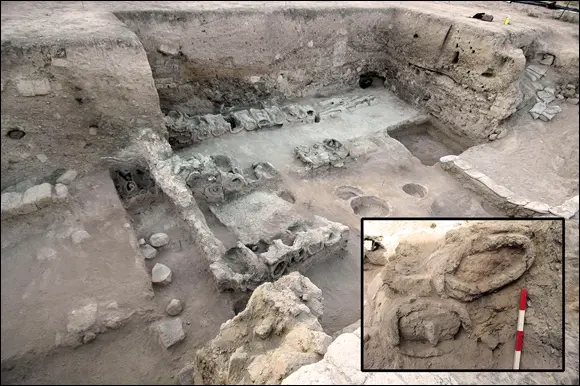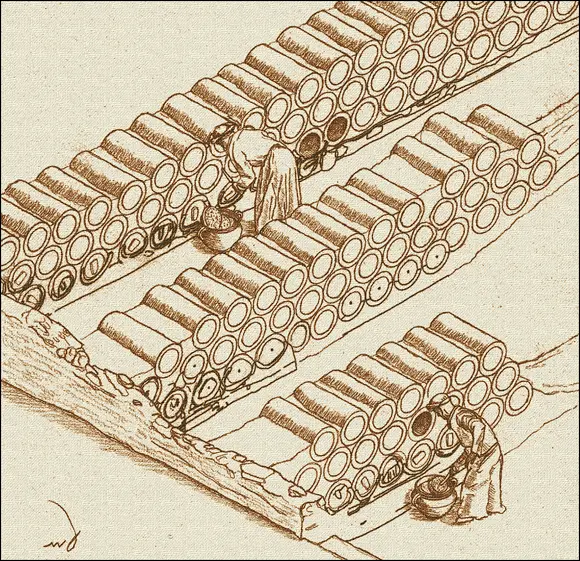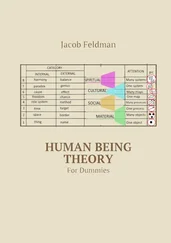The Egyptians loved their honey It was used as a sweetener in cooking and baking. It was used for paying taxes and preventing infection by being placed on wounds. An ancient Egyptian marriage vow stated, “I take thee as wife … and promise to deliver to thee twelve jars of honey each year.” Honey was even presented as tribute to the Egyptians from the countries they conquered.

Illustration by Howland Blackiston
FIGURE 1-3:Egyptian beekeepers tend to their clay hives while helpers smoke the colonies to calm the bees.
Honey was also used for religious purposes. Sacred animals were fed honey. Mummies were often embalmed in honey and propolis, and amphorae of honey were left in tombs, giving the deceased something to eat in the afterlife.
In short, the Egyptians revered honey as a very valued commodity.
As far back as the first dynasty, the Egyptians were known to value the quality and authenticity of their honey. The government assigned the title “Sealer of the Honey” to an esteemed individual who would witness all aspects of the production, insuring the best-quality honey for the Pharaohs and elite. Each vessel of prized honey was marked with an official seal insuring quality control.
Embalming with Honey and More
Spoiler alert. This section gets a little gross and may put you off honey for a while, but it’s interesting to note that due to its high acidity and hygroscopic properties, honey acts by drying out the water necessary for microbes and bacteria to survive. And when combining that with the antiseptic qualities of the hydrogen peroxide produced by honey, you have a pretty effective embalming fluid. In fact, upon his death, it is said that Alexander the Great’s body was preserved in a golden coffin filled with honey and taken back to Macedonia.
Now if that’s not gruesome enough, here’s a honey of a legend you may want to skip over. Have you ever heard of a mellified body? It is said that Mellification was a way for elderly people nearing the end of their lives to donate their body to become medicine that would be ingested by others to alleviate ailments. In short, turning the body into—yuck—a mummified human confection to be consumed for its healing properties. I’ll skip over any further details.
Discovering the World’s Oldest BeeHives
Archaeologists recently discovered ancient beehives dating back 3,000 years at the site of Tel Rehov in the Jordan valley in northern Israel (see Figure 1-4). This site appears to be the earliest physical evidence of beekeeping, around the time the prophet Elisha lived. Researchers estimate there were at least 180 hives made of clay cylinders, home to more than a million bees (shown in Figure 1-5). Archaeologists identified the remains of honey bees — including workers, drones, pupae, and larvae — inside about 30 clay hives. Each hive could have produced about 11 pounds of honey each year, making it a profitable business effort.

Courtesy of Amihai Mazar and Amihai Mazar, The Hebrew University of Jerusalem
FIGURE 1-4:The discovery of these beehives during the Tel Rehov Expedition suggests that beekeeping was already an elaborate agricultural practice in Israel 3,000 years ago.

Drawing by Ana Iamim. Courtesy of Amihai Mazar, The Hebrew University of Jerusalem
FIGURE 1-5:Artist rendering of this 3000-year-old apiary, which was estimated to have included over 180 clay hives.
This is the earliest discovery of beekeeping from ancient times. Each hive had a small hole on one side for the bees to come and go, and on the other side was a lid for the beekeeper to access the honeycomb. The archeologists used carbon dating on grains (of pollen?) that had spilled from a broken storage jar next to the hives to estimate that they were about 3,000 years old.
“The location of such a large apiary in the middle of a dense urban area is puzzling because bees can become defensive, especially during routine beekeeping inspections or honey harvesting,” the researchers wrote. They speculated that maybe the honey was so valuable it was worth placing in such a congested area where it could be watched and kept safe.
Honey is referenced in all the world’s most prominent religions. It always symbolizes richness and great wealth, usually provided through the goodness of God. Honey can be a reward or a gift, or simply a sign of prosperity and a sign of God’s blessing. Following are some examples.
The religious text of Islam called the Qur’an has an entire chapter titled al-Nahl (the Honey Bee). According to the words and deeds of the Prophet Muhammad, honey is strongly recommended for healing purposes. The Qur’an also promotes honey as a nutritious and healthy food.
Honey is one of the five foods used in Hindu worship. It is widely mentioned as an offering to God. It is described as one of the five sacred elixirs of immortality. The sacred religious texts known as the Vedas mention the use of honey as a great medicinal and health food as the food of the gods. Honey’s unique health attributes are common to all the major religions.
The Torah describes the land of Israel as “flowing with milk and honey.” In the Jewish tradition, honey is a symbol for Rosh Hashana. At the traditional meal during this New Year holiday, apple slices are dipped in honey (the apples represent life, and honey represents sweetness — grant us a good and sweet new year).
The festival of Madhu Purnima commemorates Buddha’s making peace among his disciples by retreating into the wilderness. During this retreat, a monkey brought him honey to eat. On Madhu Purnima, Buddhists remember this act by giving honey to monks.
The Bible contains 100 verses that reference honey. In the book of Judges, Samson found a swarm of bees and honey in the carcass of a lion (14:8). The book of Samuel includes, “See how my eyes have become bright because I tasted a little of this honey” (14:29). Plus, you can find 98 additional honey references!
There is a story of a prominent man who offered honey to the spiritual master, Guru Sahib. The guru refused the honey, stating that when he had needed it most, the man had refused to give it to him. When the man asked the guru for enlightenment, he pointed toward a poor Sikh who was hungry and had been denied honey by the same man. “Feeding the poor is feeding the guru,” he proclaimed.
Finding Honey in Literature and Folklore
You don’t have to look very hard to find honey referenced in popular culture. Throughout the ages, literature, folklore, mythology, and music have all praised honey in one way or another. The ancient Greeks considered honey sacred in addition to being nutritious. Greek artwork, poetry, and music celebrated honey and the bountiful honey bee.
The great Greek poet Homer referenced honey in several of his poems. The mythological Aristaios (son of Apollo) was a beekeeper, and he taught the Greeks how to maintain hives and harvest honey. For this reason, Aristaios became known as the patron god of beekeeping.
Читать дальше















